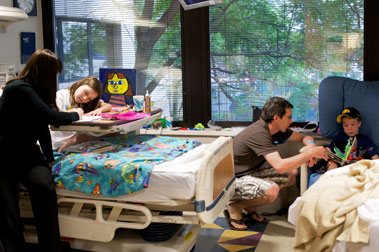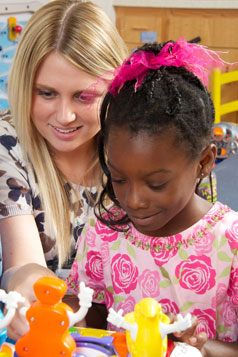 Inpatient
Inpatient
Blue Team
- Day Team consists of one 3rd year senior resident, three to four pediatric interns
- Night Team consists of one 2nd year senior resident and one pediatric intern
- Additional team members: 2nd year family medicine residents, advanced medical students (M3/M4), and clerkship students (M2/M3)
- Patients on Blue Team:
- General pediatrics
- Cardiology
- Neurology
- Pulmonology
Green Team
- Day Team consists of one 3rd year senior resident, three to four pediatric interns
- Night Team consists of one 2nd year senior resident and one pediatric intern
- Additional team members: 2nd year family medicine residents, advanced medical students (M3/M4), and clerkship students (M2/M3)
- Patients on Green Team:
- General pediatrics
- Endocrinology
- Gastroenterology
- Nephrology
Red Team
- Day Team consists of one 3rd year resident and one 2nd year resident
- Night Team typically covered by ARNP
- Additional team members: advanced medical students (M3/M4)
- Patients on Blue Team:
- Hematology
- Oncology
Newborn Nursery
- Day Team consists of one to two pediatric interns
- Night Team covered by ARNP
- Additional team members: family medicine residents and clerkship students (M2/M3)
- Includes attendance at delivery of cesarean births and performing neonatal resuscitation
Neonatal Intensive Care Unit (NICU)
- NICU has 5 bays: residents rotated through bay 2/3 as interns and bay 1 as 2nd and 3rd years
- Bay 2/3: “step down unit” includes one to two pediatric interns or family medicine residents
- Bay 1: one to two 2nd year residents rotate during the day, one 3rd year resident covers overnight shift
- Additional team members: NICU fellows, Neonatal Nurse Practitioners, medical students, occasionally Emergency Medicine residents
- Residents have opportunity to care for wide variety of neonatal conditions including extreme prematurity (22 weeks and beyond), HIE and cooling protocol, congenital diaphragmatic hernias, congenital heart disease, ECMO, and much more.
- Residents rotating on Bay 1 perform neonatal resuscitation for all emergent deliveries, unscheduled caesarean births, and sick neonates. Residents have the opportunity to perform UVC/UAC line placement, intubations, and more
Pediatric Intensive Care Unit (PICU)
- Day Team consists of two to three 2nd year resident plus off-service rotator from Anesthesia or Emergency Medicine
- Night Team covered by one to two 3rd year residents
- Additional team members: PICU fellows, advanced medical students (M3/M4)
- Black team: resident led team, medical and post-operative patients
- Gold team: ARNP led team, cardiac patients
- Residents may rotate through CVICU as an elective (encouraged for those interested in pediatric cardiology or critical care medicine)
Teaching Rotation
- Available to 2nd or 3rd year residents on certain inpatient rotations (Blue Team, Green Team, or NICU)
- Flexibility to make self-directed teaching rotation in different unit if interested
Outpatient 
Resident Continuity Clinic (RCC)
- All residents assigned to one weekday for duration of residency
- Allows for consistency with colleagues, nurses, and general pediatric attendings
- During most blocks, residents spend one half-day per week in RCC caring for their own panel of patients
- Most residents have RCC at UIHC Iowa River Landing (IRL) and a few have RCC at UIHC North Liberty Pediatrics
- During the third year, residents can spend their RCC in a specialty of their choosing (e.g., if pursuing cardiology, resident will have RCC at pediatric cardiology clinic)
General Pediatrics Acute Care Clinic (GPC)
- Residents provide primary care service under supervision of academic general pediatricians
- Residents rotate through GPC twice during intern year (2-3 interns on per block), and once as 3rd year acting in senior role
- Additional rotators include residents from family medicine, psychiatry, family medicine/psychiatry, and dentistry. Clerkship medical students (M2/M3) also present most blocks
- Rotation performed at UIHC Iowa River Landing Clinic (IRL)
Adolescent Medicine Rotation
- Residents in their second year will rotate through Adolescent clinic and partner with adolescent medicine specialist for care of adolescents and young adults
- Adolescent Clinic is located at UIHC Iowa River Landing (IRL)
- Additional clinical opportunities include UI LGBTQ clinic, UI Sports Medicine Clinic, Healthy Kids School-based clinic
- 3rd year residents can rotate through adolescent as elective for additional adolescent directed learning
Developmental and Behavioral Pediatrics
- Residents rotate through CDD (Center for Disabilities and Development) during their intern year
- Residents participate in the management of children with attention deficit disorders, psychosomatic diseases, behavioral problems, learning disabilities, and more
Community Pediatrics and Advocacy Rotations
- Second year residents spend one block working in a busy private pediatrics practice in Cedar Rapids, IA (within 30 min of Iowa City)
- Up to one day per week during this block is spent at a school-based clinic at a local junior high with one of our general pediatricians
- This is different than an advocacy elective (see details under Advocacy tab)
- Residents are able to work in an independent fashion with guidance and supervision provided by community pediatricians
- Transportation provided by the program
Electives
- Flexibility to make your own rotation to individualize training to meet personal goals
- Six blocks of electives available across three years
- Many residents tailor their electives to prepare for independent practice or fellowship
- Popular clinical electives include Infectious disease, palliative care, dermatology, and research
- Popular specially designed electives include maternity/paternity electives, teaching rotations, procedure electives, advocacy projects, and research
- More information about popular electives can be found here